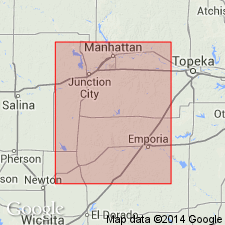
- Usage in publication:
-
- Marion flint
- Modifications:
-
- Named
- Dominant lithology:
-
- Limestone
- Flint
- AAPG geologic province:
-
- Sedgwick basin
- Nemaha anticline
Summary:
Named as unranked unit near top of Chase formation (new) in Marion Co, KS (Sedgwick basin) and found in Butler, Chase, and Morris Cos, KS (Nemaha anticline). "The highest flint and limestone is well exposed along the bluffs of the river and small streams near Marion and its base is about 123 feet above the base of the Florence flint. Near Marion...is a flinty limestone about 4 feet thick...The flint is not as uniform in occurrence as in the Florence and Strong flints, so at some localities this horizon is represented simply by a prominent light gray limestone nearly free from flint... This flint and concretionary limestone is the highest prominent flint ledge in the upper Paleozoic of Kansas. It forms marked stratigraphic horizon...and on account of the good exposures of this zone near Marion City, the horizon has been called the Marion flint and concretionary limestone." Marion flint separated from Marion concretionary limestone (above) by 13+ ft of yellowish shales containing a few brachiopods. Characteristic fossils listed in table (p. 797). Assigned to Permian series of Carboniferous period.
Source: GNU records (USGS DDS-6; Denver GNULEX).
For more information, please contact Nancy Stamm, Geologic Names Committee Secretary.
Asterisk (*) indicates published by U.S. Geological Survey authors.
"No current usage" (†) implies that a name has been abandoned or has fallen into disuse. Former usage and, if known, replacement name given in parentheses ( ).
Slash (/) indicates name conflicts with nomenclatural guidelines (CSN, 1933; ACSN, 1961, 1970; NACSN, 1983, 2005, 2021). May be explained within brackets ([ ]).

